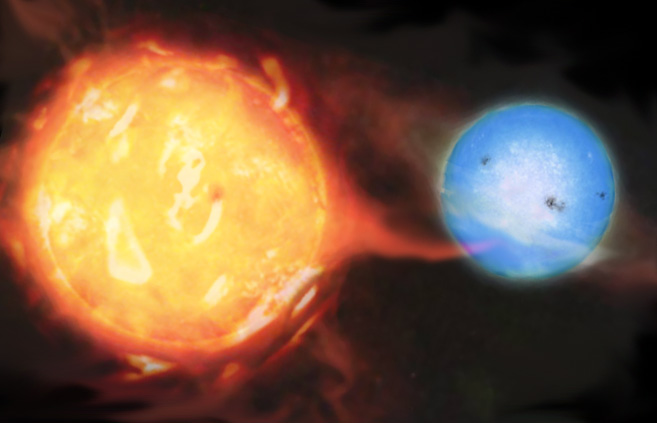43221lynx wrote:The link to "blue stragglers" states:
the two ways that blue stragglers — or "rejuvenated" stars — in globular clusters form. The upper illustration shows the collision model where two low-mass stars in an overcrowded environment experience a head-on collision, combining their fuel and mass and to form a single hot star. The lower illustration depicts the "vampire" model consisting of a pair of stars that undergo a transformation, with the lower-mass star draining its larger-mass companion of hydrogen that fuels its rebirth.
Two questions,
Why are the stragglers called stragglers?
How does a star with lower mass "drain" hydrogen from one of greater mass? Gravity can't do it can it? EM forces? How?
Good question.
This wikipedia article will answer at least some of your questions.
Personally I'd like to call attention to the second brightest star in constellation Perseus, Algol. In the star chart on the left, the pink arrow points at Algol.
Algol is a double star - really a triple star, but that does not really concern us here. The two main components are a main sequence (hydrogen-fusing) blue star of spectral class B8V, and an orange giant of spectral class K or late G. The blue component is about ninety times brighter than the Sun. In order to be so bright and blue, a star has to be massive, and
according to professor Jim Kaler, the blue component contains 3.4 times as much mass as the Sun.
But massive stars evolve fast. The more massive they are, the bluer they are when they are young, but the faster they evolve and leave their "blue youth" behind. Soon (say, after a few hundred million years or less), the blue star will have used up the hydrogen in its core. When that happens, the star will swell up and become a red giant. As a red giant, the star is
very much bigger than before. Because the red giants are so big, they are also brighter than they were during their "main sequence youth". But because they are so big, they don't "hold on to" their outer layers as well as they did when they were younger and much more compact.
Albireo. Credit: Conrad Jung.
A more massive star is brighter in its youth than a less massive star. It will also run through its main sequence life time faster than a less massive star. As the more massive star swells up, turning into a red giant, it will become even brighter than before. Its less massive companion, by contrast, will still be a main sequence star by the time its more massive companion turns into a red giant. Therefore the smaller star will remain more or less as bright as it was before (for a time), and it will also maintain its color and temperature (for a time). Usually, when the more massive component of a binary pair swells up, you get an orange or a yellowish primary giant star and a bluish secondary main sequence star. A well-known example is Albireo.
But Algol is not like Albireo! The main sequence blue star is
much brighter than the orange giant. The orange star is a bit bigger than the blue primary, but not by much at all -
the radius of the blue star is 2.9 solar radii, and the orange star is 3.5 solar. And the blue star is by far the more massive of the two, 3.7 solar masses versus only 0.81 solar masses for the orange star.
Yet it is clear that the blue star is a main sequence star, which fuses hydrogen to helium in its core, whereas the orange star has already used up its core hydrogen. So how can the orange star be so small, faint and light-weight, then, when it ought to be gigantic, relatively massive and very bright?
This is what has happened. The two main components of Algol are close together. When the more massive component used up its core hydrogen and started to swell, its outer layers came too close to the more compact secondary star. The gravitational attraction from the smaller, compact star was now stronger than the gravitational attraction from the giant star. As the smaller star began to "eat" the outer layers of its giant companion, the small star became more massive. As it became more massive its gravity grew stronger, and it could capture even more of its swollen companion's outer layers. Eventually, the small companion had turned into a bright, blue, B-type main sequence star, even though it must have been smaller, fainter, more light-weight and yellower from the beginning. The giant, on the other hand, became terribly shrunken and emaciated.
This would be a way for blue stragglers to be created. Imagine two stars, one about as massive as the Sun and the other one less massive. After ten billion years or so, the solar mass star would swell into a red giant. But if its companion was close enough, it might capture the outer layers of the swollen giant. Eventually, this could lead to the small companion gaining so much mass that it turned into a blue straggler.
Blue stragglers are called stragglers because they are "lagging behind": they remain (relatively) blue and are found on the main sequence long after (almost) all other blue stars have used up their core hydrogen and turned into red giants or white dwarfs.
Ann
 Hubble's Messier 5
Hubble's Messier 5


